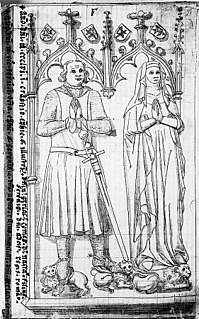
Adolf was the count of Nassau from about 1276 and the elected king of Germany from 1292 until his deposition by the prince-electors in 1298. He was never crowned by the pope, which would have secured him the imperial title. He was the first physically and mentally healthy ruler of the Holy Roman Empire ever to be deposed without a papal excommunication. Adolf died shortly afterwards in the Battle of Göllheim fighting against his successor Albert of Habsburg.

The County of Nassau was a German state within the Holy Roman Empire and later part of the German Confederation. Its ruling dynasty, the male line of which is now extinct, was the House of Nassau.

Idstein is a town of about 25,000 inhabitants in the Rheingau-Taunus-Kreis in the Regierungsbezirk of Darmstadt in Hesse, Germany. Because of its well preserved historical Altstadt it is part of the Deutsche Fachwerkstraße, connecting towns with fine fachwerk buildings and houses. In 2002, the town hosted the 42nd Hessentag state festival.

For armorial/coats of arms see: Armorial of the House of Nassau
Walram II of Nassau, German: Walram II. von Nassau, was Count of Nassau and is the ancestor of the Walramian branch of the House of Nassau.
Henry II "the Rich" of Nassau, German: Heinrich II. "der Reiche" von Nassau was Count of Nassau. He distinguished himself in particular by his chivalrous and devout spirit. He was charitable and made great donations to the church, so that the monasteries and prayer houses in the area of present-day Nassau experienced the most significant bloom in his time. The greatest favour was the Teutonic Order to enjoy, to which he donated especially for the renunciation of his brother's, upon his entry into the order. Henry participated in the Sixth Crusade. He was the builder of the castles Sonnenberg, Ginsburg and Dillenburg.

Gerlach I of Nassau, Count of Nassau in Wiesbaden, Idstein, Weilburg, and Weilnau.

Frauenstein is the westernmost borough of the city of Wiesbaden, located in the Rhine Main Area near Frankfurt and capital of the federal state of Hesse, Germany. The borough has a population of approximately 2,400. The formerly independent village was incorporated into Wiesbaden in 1928.

Imagina of Isenburg-Limburg was the Queen consort of Adolf of Nassau, King of Germany.
Klarenthal Abbey is a former convent of the Order of Poor Ladies in the borough of Klarenthal in Wiesbaden, Germany. Klarenthal was the only abbey in present-day Wiesbaden.
Rupert IV of Nassau, German: Ruprecht IV. von Nassau, was Count of Nassau. He later became a Knight of the Teutonic Order.
Walram I of Nassau, German: Walram I. von Nassau, also known as Walram I of Laurenburg, was Count of Nassau and is the oldest Nassau whose ancestorship is absolutely certain. He managed to expand his territory considerably during his reign. He took part in the Third Crusade.

William Louis of Nassau-Saarbrücken, was a Count of Saarbrücken.
Count John of Nassau-Idstein was Count of Nassau and Protestant Regent of Idstein.

Philip IV of Nassau-Weilburg, also known as Philip III of Nassau-Saarbrücken was Count of Nassau-Weilburg from 1559 until his death and since 1574 also Count of Nassau-Saarbrücken. Both possessions belonged to the Walram line of the House of Nassau. In Weilburg, he was the fourth count named Philip, but only the third in Saarbrücken, because his father, Philip III of Nassau-Weilburg never held Nassau-Saarbrücken.
Adolph II, Count of Nassau-Wiesbaden-Idstein was a son of Walram IV, Count of Nassau-Idstein his wife, Bertha of Westerburg. He married in 1418 with Margaret (1404–1442), a daughter of Bernard I, Margrave of Baden-Baden. After his father's death in 1393, he ruled Nassau-Wiesbaden and Nassau-Idstein.
Count Adolf III of Nassau-Wiesbaden-Idstein was a son of Count John II of Nassau-Wiesbaden-Idstein and his wife Maria of Nassau-Dillenburg (1463–1504). After his father's death in 1480, he ruled Nassau-Wiesbaden and his brother Philip ruled Nassau-Idstein. After Philip's childless death in 1509, Adolf III ruled also ruled Nassau-Idstein.
Adolph I, Count of Nassau-Wiesbaden-Idstein was a son of Count Gerlach I and Agnes of Hesse. In 1344, his father abdicated in favor of his sons. They ruled jointly until 1355, then divided their inheritance:
Rupert, Count of Nassau-Sonnenberg, nicknamed the Bellicose, was a son of Gerlach I, Count of Nassau and his second wife, Irmgard of Hohenlohe.
Adelheid of Katzenelnbogen, German: Adelheid von Katzenelnbogen was a countess from the House of Katzenelnbogen and, by marriage, countess of Nassau. She is a direct ancestor of the Walramiam branch of the House of Nassau and of the Grand Dukes of Luxembourg.


















